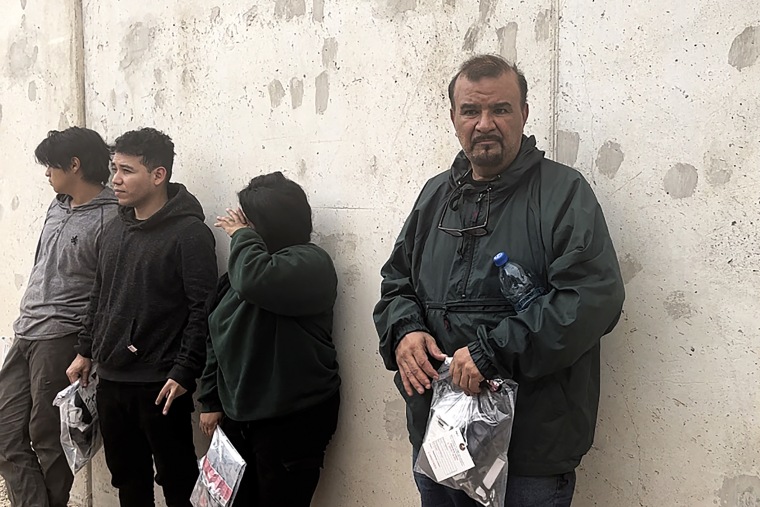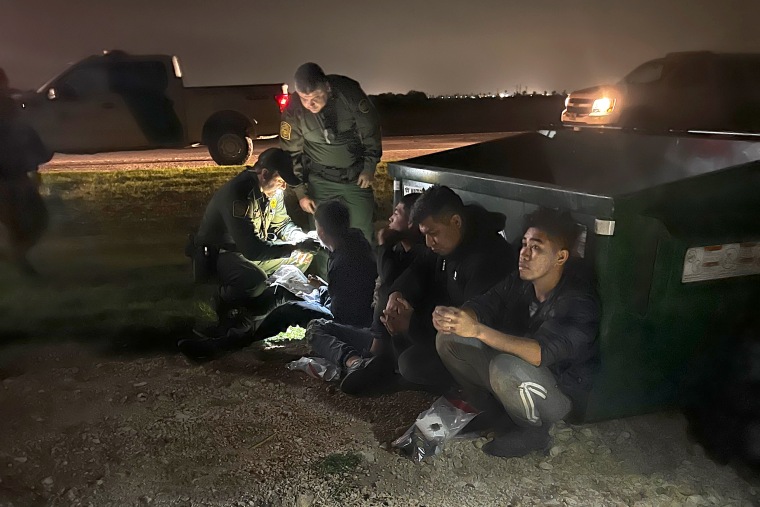GRANJENO, Texas — As the sun rose over the Rio Grande, U.S. border agents on patrol found and apprehended five Colombian migrants who had just crossed the river into Texas only to be confronted by a 25-foot-high border wall.
One of those caught by the Border Patrol, a 30-year-old Colombian, said he came to the U.S. as “last resort” because he “couldn’t live anymore.”
He said he was extorted and his wife was threatened during his long journey north.
On Thursday morning, he became one of the more than 2,000 apprehensions the Rio Grande Valley sector of southeast Texas now averages each day, according to Customs and Border Protection officials.
Homeland Security Secretary Alejandro Mayorkas visited with border agents in the valley on Thursday ahead of the lift of the Covid ban known as Title 42, which has turned migrants back to Mexico more than 2.5 million times since it was imposed in March 2020.
Border agents here are preparing for a massive surge when Title 42 ends on May 11. But here and in many other sections of the border, the surge has already begun.
Agents in the Rio Grande Valley said they’re already seeing a rise in migration because smuggling organizations brought migrants to northern Mexico ahead of Title 42’s expected lift and are now starting to move them into the U.S. to free up space.
Most migrants that Border Patrol has encountered recently, as observed by NBC News and other media organizations, had never heard of Title 42 but had paid a smuggler who directed them on when to cross.
A Border Patrol official said the processing centers in the Rio Grande sector are technically at capacity, but can still comfortably fit migrants who enter before they’re either turned back under Title 42, detained by Immigration and Customs Enforcement or released to local shelters.
The concern, the Border Patrol official said, is the time it will take to process migrants when Title 42 goes away. Rather than one agent processing and sending 40 migrants back to Mexico under Title 42 in five minutes, it will take one agent 30 minutes to an hour to process just one migrant and determine where he or she will go next, the official said.
That slowdown could result in backups in Border Patrol stations and a drain on the manpower of border agents in the area, the official said.
In Brownsville, Texas, thousands of migrants per day have crossed across a defunct golf course. To avoid the chaos that occurred during a surge in Del Rio, Texas, in September 2021, Border Patrol has been quickly processing migrants and ICE has been rapidly transferring them out of the area by bus.

As Mayorkas tours the Rio Grande Valley, Department of Homeland Security officials have been touting the sector’s recent success in processing migrants quickly. But the numbers of migrants are growing — the sector is now the third busiest sector year to date. In El Paso, the busiest sector over the past year, shelter operators and local officials estimate that the more than 1,000 migrants whom they were unable to accommodate are now sleeping on the streets.
Mayorkas and border officials have also touted advances in technology for finding and processing migrants. Since fiscal year 2022, the Biden administration has added 81 new autonomous surveillance towers that use artificial intelligence technology to track movement and know the difference between a person and a deer crossing through the brush.
DHS has increased its surveillance technology, but so too have human smugglers. As Border Patrol agents made their way along the Rio Grande under the Anzalduas International Bridge, which connects Mexico with McAllen, Texas, they spotted a drone flying high above them, tracking their movements. Border Patrol agents said it was likely operated by a human smuggler determining how to best bring across a group of migrants without being detected.

